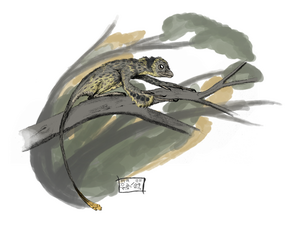Epidendrosaurus
| Epidendrosaurus | ||||||||||||
|---|---|---|---|---|---|---|---|---|---|---|---|---|

Epidendrosaurus |
||||||||||||
| Temporal occurrence | ||||||||||||
| Middle Jura to Upper Jura | ||||||||||||
| 167.7 to 150.8 million years | ||||||||||||
| Locations | ||||||||||||
| Systematics | ||||||||||||
|
||||||||||||
| Scientific name | ||||||||||||
| Epidendrosaurus | ||||||||||||
| Zhang , Zhao , Xu & Wang , 2002 | ||||||||||||
Epidendrosaurus (= "lizard on the tree") was a small, bird-like dinosaur from the Maniraptora group . A closely related find was initially described as Scansoriopteryx (= "climbing wing"), but it is probably a synonym .
description
So far only fossils of young animals about the size of a house sparrow have been found . The exact appearance and size of adults is currently unknown. The outstanding feature was the greatly elongated third finger, the exact function of which is not yet known. The front limbs in general and the second limb of the second finger were also elongated. The hind legs ended in four relatively short toes. The tail was comparatively long and should have been feathered like tufts at the end. In the specimen originally named Scansoriopteryx , the tail was significantly shorter. There were at least twelve teeth in the lower jaw, which became smaller towards the back.
The structure of the feet and the forelegs could have spoken in favor of a tree-dwelling way of life for these animals. The extended third finger should not have played a role in climbing, however. It was possibly used - similar to the finger animal , which has a similar structure - to pick insects out of the tree bark.
Discovery history and naming
Almost at the same time, two fossil finds from China were described in 2002 . Fucheng Zhang, Zhonghe Zhou, Xing Xu, Xiaolin Wang described a specimen named Epidendrosaurus ningchenensis from the Daohugou Formation in Ningcheng County, Inner Mongolia Autonomous Region . Stephen Czerkas and Chongxi Yuan described their specimen called Scansoriopteryx heilmanni from the neighboring province of Liaoning . The age of the finds is still controversial, it is assumed that they date back to the Middle or Upper Jurassic .
The two genera were very similar and were united in the family Scansoriopterygidae. Some works assume that it is a synonym.
In the case of a multiple description of a taxon, according to the rules of the ICZN, the name described earlier is valid. Procedural reasons - E. ningchenensis was initially published online and not in print - led the ICZN to deal with the case and recognize Epidendrosaurus as a valid name.
Systematics
Since so far only young animals have been found that only allow limited conclusions about the appearance of adult animals, the systematic classification of Epidendrosaurus is unclear. The first descriptors concluded from anatomical features a clear affiliation to the Coelurosauria . The greatly elongated third finger is a feature that does not appear in either non-avian theropods or early birds such as Archeopteryx . On the other hand, Czerkas and Yuan, the first to describe the specimen called Scansoriopteryx , pleaded for an unorthodox classification that contradicts current opinions on the dinosaur systematics. The exact systematic position is unclear, it is listed as Aviala (bird in the broader sense) incertae sedis .
literature
- David B. Weishampel , Peter Dodson , Halszka Osmólska (eds.): The Dinosauria . 2nd edition. University of California Press, Berkeley CA et al. 2004, ISBN 0-520-24209-2 .
- Fucheng Zhang, Zhonghe Zhou , Xing Xu , Xiaolin Wang: A juvenile coelurosaurian theropod from China indicates arboreal habits. In: The natural sciences . Vol. 89, No. 9, 2002, pp. 394-398, doi : 10.1007 / s00114-002-0353-8 .
Individual evidence
- ↑ about Weishampel et al .: The Dinosauria . 2004, p. 216.
- ^ Jerald D. Harris: 'Published works' in the Electronic Age: recommended amendments to Articles 8 and 9 of the Code. In: The Bulletin of Zoological Nomenclature. Vol. 61, No. 3, 2004, ISSN 0007-5167 , pp. 138-148, digitized .
- ↑ Stephen A. Czerkas, Chongxi Yuan: An arboreal Maniraptoran from Northeast China. The Dinosaur Museum, Blanding UT 2002, (PDF; 198 kB).
- ^ Weishampel et al: The Dinosauria . 2004, p. 216.
